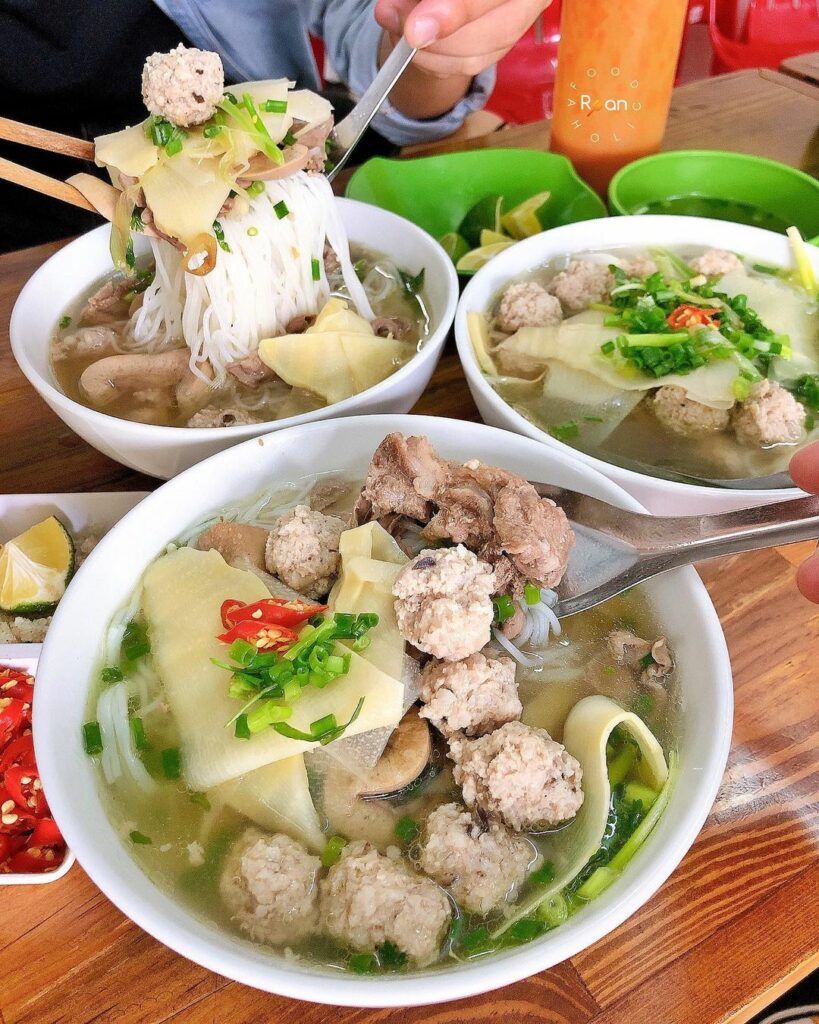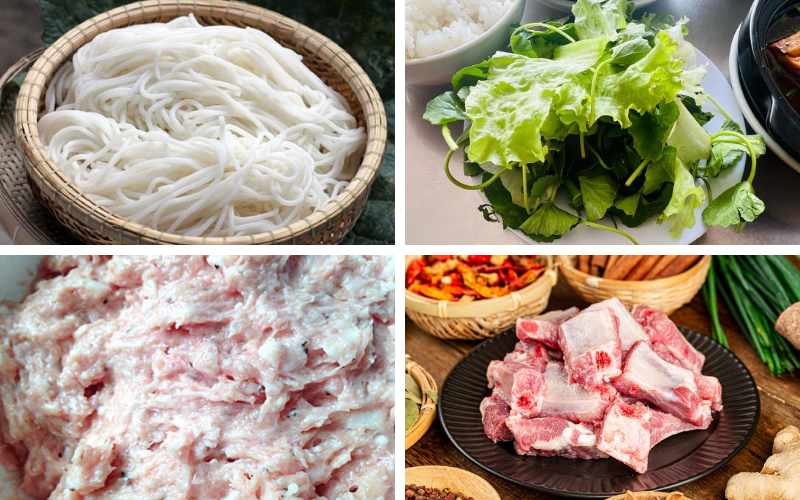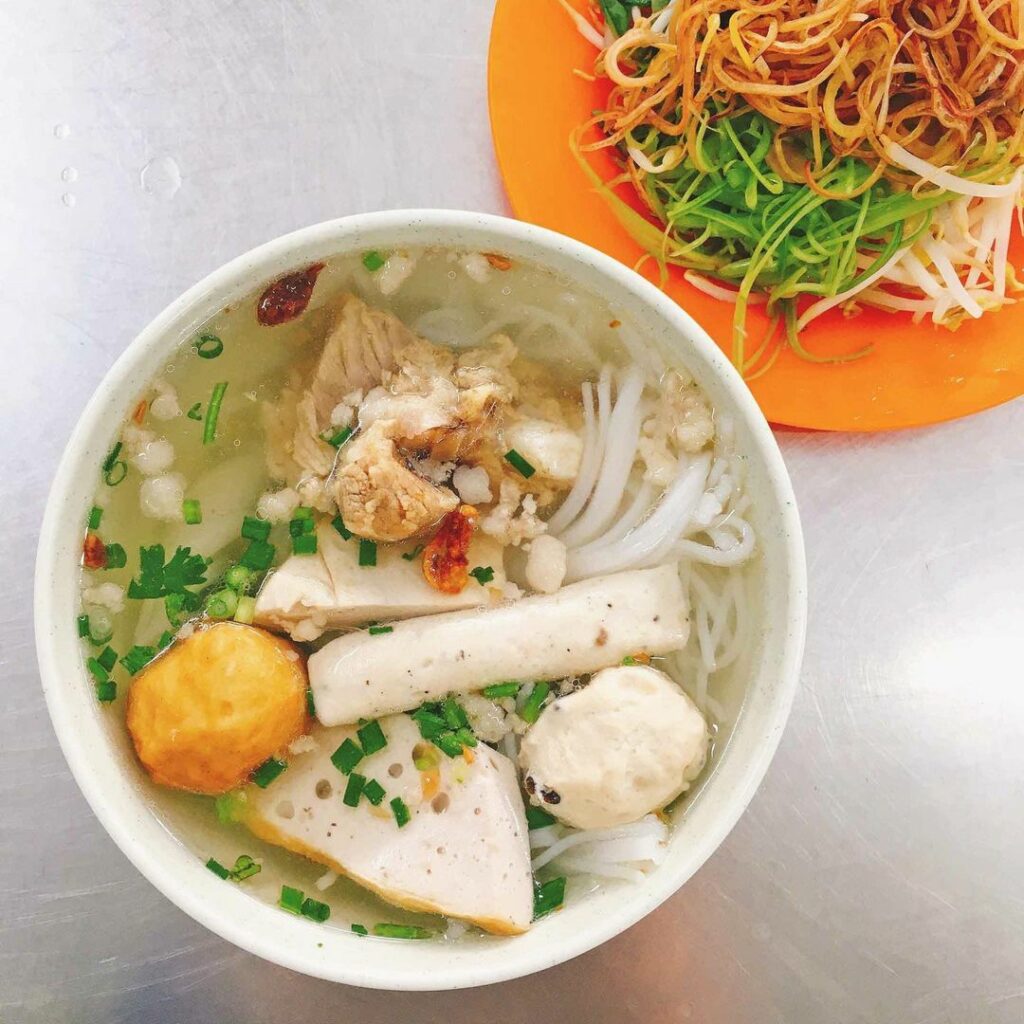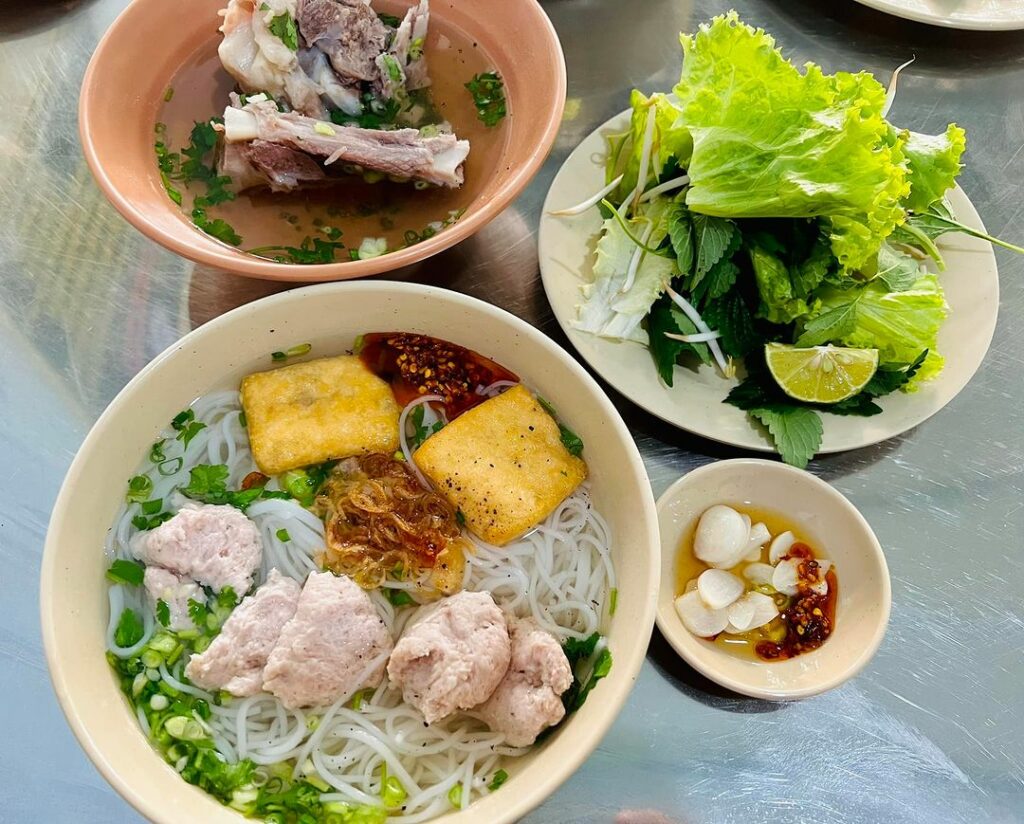Bun Moc, a beloved dish from Vietnam, is a culinary delight that encapsulates the essence of Vietnamese cuisine. This flavorful soup features tender meat, fragrant herbs, and delicate rice noodles, all immersed in a savory broth.
Whether you’re a fan of traditional recipes or eager to explore new flavors, mastering the art of Bun Moc will transport your taste buds to the vibrant streets of Vietnam. From its humble origins to its widespread popularity worldwide, join us on a journey that celebrates the art of this delectable recipe.
What is bun moc?

Bun Moc is a traditional Vietnamese dish renowned for its delectable flavors and aromatic broth. It is a noodle soup dish consisting of tender meat, typically pork or chicken, combined with rice noodles and an assortment of fresh herbs.
The defining characteristic of Bun Moc Vietnamese lies in its flavorful broth, which is crafted by simmering bones and aromatic spices for hours, resulting in a rich and fragrant base. This beloved dish originated in northern Vietnam and has since gained popularity throughout the country and beyond.
With its roots deeply embedded in Vietnamese culinary history, Bun Moc serves as a testament to the diverse and vibrant flavors found in Vietnamese cuisine.
Bun moc recipe

The bun moc recipe serves as a guide. Adjust the ingredients and measurements according to your preferences.
Cooking note
- Yield: 4 servings
- Prep Time: 20 minutes
- Cook Time: 2 hours
- Total Time: 2 hours and 20 minutes
- Course: Main Course
- Cuisine: Vietnamese
- Equipment:
- Stockpot or large pot
- Strainer or sieve
- Cooking utensils
Ingredients
- 500 grams pork bones (or chicken bones)
- 300 grams ground pork
- 200 grams pork tenderloin, sliced
- 200 grams rice noodles (Bun)
- 1 onion, sliced
- 4 cloves garlic, minced
- 1 tablespoon fish sauce
- 1 teaspoon sugar
- 1 teaspoon salt
- 1 teaspoon ground black pepper
- 1 teaspoon annatto seeds (optional, for color)
- Fresh herbs (Thai basil, cilantro, mint) for garnish
- Bean sprouts, lime wedges, and chili slices for serving
Note: Feel free to add additional vegetables or herbs based on personal preference.
How to make bun moc?
A step-by-step guide to preparing Bun Moc Vietnamese
Preparing the broth
- In a stockpot, add the pork bones and cover with water. Bring to a boil.
- Reduce the heat to low and simmer for at least 1.5 to 2 hours, skimming off any impurities that rise to the surface.
- Add the onion, garlic, fish sauce, sugar, salt, black pepper, and annatto seeds (if using) to the broth. Simmer for an additional 30 minutes.
- Strain the broth to remove any solids and keep it warm.
Making the bun moc noodles
- Cook the rice noodles according to the package instructions.
- Drain and set aside.
Cooking the meat and toppings
- In a separate pot, bring water to a boil and blanch the pork tenderloin slices for about 2–3 minutes until cooked. Remove from the pot and set aside.
- In a small bowl, season the ground pork with salt, pepper, and minced garlic. Mix well.
- Shape the seasoned ground pork into small meatballs.
- Bring the broth back to a simmer and gently drop the meatballs into the broth. Cook for about 5–7 minutes until the meatballs are cooked through.
Assembling the bun moc bowl
- Divide the cooked rice noodles into serving bowls.
- Add the cooked pork tenderloin slices and meatballs on top of the noodles.
- Ladle the hot broth over the noodles and meat.
- Garnish with fresh herbs such as Thai basil, cilantro, and mint.
- Serve the Bun Moc bowls with bean sprouts, lime wedges, and chili slices on the side.
- Mix the ingredients together before enjoying the flavorful and aromatic Bun Moc.
Note: Adjust the seasoning and toppings according to your taste preferences. Feel free to add additional herbs, vegetables, or condiments for extra flavor and texture.
How many calories is in bun moc?
Here is a general estimation of the caloric content of Bun Moc Vietnamese
| Ingredients | Calories (per serving) |
| Pork bones (or chicken) | 50-100 |
| Ground pork | 200-250 |
| Pork tenderloin | 150-200 |
| Rice noodles (Bun) | 200-250 |
| Onion | 10-20 |
| Garlic | 5-10 |
| Fish sauce | 5-10 |
| Sugar | 10-20 |
| Salt | 0-5 |
| Black pepper | 0-5 |
| Annatto seeds (optional) | 0-5 |
| Fresh herbs and garnishes | Negligible |
| Bean sprouts, lime, chili | Negligible |
| Broth and seasonings | Varies |
| Total | Approximately 650-900 |
Note: The above calorie values are approximate and can vary based on the specific brands and quantities of ingredients used.
Macronutrient breakdown of bun moc
The macronutrient breakdown of Bun Moc can vary depending on the specific recipe and portion sizes. However, here is a general overview of the macronutrient distribution:
- Protein: Approximately 20-25 grams per serving
- Carbohydrates: Approximately 40-50 grams per serving
- Fat: Approximately 10-15 grams per serving
Health benefits of key ingredients in bun moc
- Pork: Provides a good source of protein, vitamins, and minerals.
- Rice Noodles: Gluten-free and low in fat, they serve as a source of carbohydrates for sustained energy.
- Fresh Herbs: Thai basil, cilantro, and mint offer antioxidants, vitamins, and minerals.
- Garlic and Onion: Contain immune-boosting properties and potential cardiovascular benefits.
- Fish Sauce: Adds a savory umami flavor and may provide essential minerals.
- Bean Sprouts: Rich in fiber, vitamins, and minerals, adding crunch and texture to the dish.
Note: The health benefits may vary depending on the individual’s overall diet and ingredient choices within the recipe.
What to serve with bun moc?

These suggestions are based on traditional Vietnamese dining customs and can be tailored to personal taste and preference.
Traditional garnish and seasoning for bun moc
Bean sprouts: Fresh bean sprouts create crunchiness for the dish.
- Lemon wedge: Squeezing lemon juice on Bun Moc enhances the flavor and brings a refreshing feeling.
- Chili slices: For those who like to eat hot, sliced chili can be added to the bowl for extra flavor.
- Shrimp sauce: You can mix shrimp paste with a little sugar and lemon, chili to dip it with topping in Bun Moc.
- Herbs: Basil, coriander and mint are herbs often used to decorate Bun Moc to add fragrance and freshness.
- Water spinach glory: You can use grated water spinach to eat with Bun Moc
Rites and customs when eating bun moc in Vietnam:
- Chopsticks and spoons: In Vietnam, people often use chopsticks to pick up noodles and pick up meat, while spoons are used to scoop up the broth.
- Sniffing: It is possible to slurp vermicelli when eating Bun Moc, because it is an expression of enjoying the dish.
- Sharing: Bun Moc is often enjoyed as a common dish, everyone scoops up a pot or a bowl.
- Spices: Feel free to customize your Bun Moc flavor by adding seasonings and garnishes to your taste.
Variations of bun moc
Bun Moc, a versatile Vietnamese dish, offers various exciting variations that cater to different preferences and dietary choices. Here are a few popular variations:
- Bun Moc Chay (Vegetarian Bun Moc): In this variation, the meat is substituted with tofu, mushrooms, or soy-based protein alternatives, providing a flavorful and satisfying vegetarian option.
- Bun Moc Gio Heo (Bun Moc with Pork Hock): This version includes succulent pieces of pork hock, which add richness and a unique texture to the dish. The gelatinous nature of the pork hock enhances the overall flavor profile of Bun Moc.
- Seafood Bun Moc: Instead of using meat, seafood such as shrimp, fish, or squid can be added to the broth, infusing the dish with a delightful oceanic flavor.
- Bun Moc Dac Biet (Special Bun Moc): This variation includes a combination of different meats, such as pork, beef, and chicken, providing a diverse range of flavors and textures in a single bowl.
- Spicy Bun Moc: For those who enjoy a bit of heat, adding chili sauce or extra chili peppers to the broth can elevate the spice level and create a fiery version of Bun Moc.
Creativity knows no bounds when it comes to fusion cuisine. Chefs and food enthusiasts have experimented with incorporating Bun Moc flavors into other dishes like salads, spring rolls, or even sandwiches, resulting in innovative and delicious creations.
Substitute ingredient of bun moc
Bun Moc Vietnmaese offers flexibility when it comes to ingredient substitutions, allowing you to customize the dish based on dietary preferences or ingredient availability. Here are a few common ingredient substitutions for Bun Moc:
Meat substitutes
- For vegetarians or vegans: Replace pork or chicken with tofu, tempeh, or seitan.
- Seafood alternatives: Use shrimp, fish, or squid as a substitute for meat.
Noodle substitutes
- Gluten-free option: Replace rice noodles with gluten-free noodles like bean thread noodles or sweet potato noodles.
- Low-carb option: Substitute with zucchini noodles (zoodles) or shirataki noodles.
Broth flavorings
- Vegetarian broth: Use vegetable broth instead of meat-based broth for a vegetarian or vegan version.
- Flavor enhancers: Add soy sauce or mushroom seasoning to enhance the umami flavors in the broth.
Garnish substitutes
- Herb alternatives: Replace Thai basil, cilantro, or mint with other fresh herbs like parsley or dill.
- Crunchy elements: Swap bean sprouts with thinly sliced cucumber or jicama for a refreshing crunch.
Spices and seasonings
- Adjust spice level: Increase or decrease the amount of chili peppers, chili sauce, or black pepper based on personal preference.
How to store bun moc?
It’s important to consume stored Bun Moc within a few days and follow proper food safety guidelines. If the ingredients show signs of spoilage or an off odor, it’s best to discard them.
Storing bun moc
- Broth: Allow the broth to cool completely before storing. Transfer it to an airtight container and refrigerate for up to 2-3 days.
- Meat and Noodles: Store the cooked meat and noodles separately in airtight containers in the refrigerator. They can be kept for 2-3 days.
Preserving ingredients
- Broth: To preserve the quality of the broth, it’s best to strain out the solid ingredients before storing. This helps prevent the broth from becoming cloudy or absorbing any unwanted flavors.
- Meat and Noodles: To maintain their texture, keep the meat and noodles separate from the broth and store them in their own containers. This prevents them from getting overly saturated.
Reheating bun moc
- Broth: Reheat the stored broth on the stovetop over medium heat until it reaches a gentle simmer. Avoid boiling the broth to maintain its flavors and prevent overcooking.
- Meat and Noodles: Dip the cooked meat and noodles briefly in hot water to warm them up. Be careful not to overcook the noodles, as they can become mushy.
Alternatively, you can add the meat and noodles directly into the reheated broth and allow them to warm through.
Common mistakes when making bun moc

When making Bun Moc, there are a few common mistakes that can occur. Here are some to be mindful of:
- Overcooking the broth: Simmering the broth for too long or at too high heat can lead to a broth that is overly concentrated or cloudy. It’s important to simmer the broth gently and for the appropriate amount of time to extract flavors without overdoing it.
- Overcooking the meat: Whether it’s pork, chicken, or seafood, overcooking the meat can result in tough and dry textures. It’s crucial to monitor the cooking time and ensure the meat is cooked just until tender and fully done.
- Not properly seasoning the broth: The flavor of the broth is a key element in Bun Moc. Neglecting to season the broth adequately with fish sauce, sugar, salt, and other spices can result in a bland or unbalanced taste. Taste and adjust the seasoning as needed during the cooking process.
- Using incorrect noodle texture: Rice noodles used in Bun Moc should be cooked until they are tender yet still slightly chewy. Overcooking the noodles can make them mushy and impact the overall texture of the dish.
- Neglecting fresh herbs and garnishes: Fresh herbs like Thai basil, cilantro, and mint are essential for adding brightness and aroma to Bun Moc. Forgetting to include or garnish the dish with these herbs can result in a less flavorful experience.
- Overloading the bowl: When assembling the Bun Moc bowl, it’s important not to overcrowd it with too many ingredients. Balancing the amounts of noodles, meat, broth, and garnishes is crucial for a well-proportioned and enjoyable dish.
Cooking tips for bun moc
Here are some helpful cooking tips to elevate your Bun Moc preparation:
- Skim the broth: While simmering the broth, skim off any impurities or foam that rise to the surface. This helps ensure a clearer and more flavorful broth.
- Toast the spices: To enhance the fragrance and flavors, consider toasting the spices like cloves, star anise, or cinnamon sticks before adding them to the broth. This extra step can add depth to the overall taste.
- Marinate the meat: If using sliced pork tenderloin, marinating it for a short time in a mixture of fish sauce, garlic, and pepper can enhance its flavor and tenderness.
- Keep the noodles separate: Cook the rice noodles separately from the broth and meat. This prevents the noodles from becoming overly soft and mushy, especially if storing any leftovers.
- Customize the toppings: Don’t be afraid to experiment with different toppings and garnishes. Add bean sprouts, lime wedges, chili slices, and fresh herbs to personalize the flavor and texture of each bowl.
- Serve piping hot: To fully enjoy the flavors of Bun Moc, serve it piping hot. Warm up the bowls, heat the meat and noodles, and ladle the hot broth just before serving.
- Don’t overlook presentation: Bun Moc is as much about the visual appeal as it is about taste. Take the time to arrange the ingredients attractively and garnish the bowl with vibrant herbs for an inviting presentation.
FAQs
Is Bun Moc gluten-free?
Yes, Bun Moc can be gluten-free. The traditional rice noodles used in Bun Moc are typically gluten-free. However, it’s essential to check the specific brand of rice noodles you are using, as some may contain traces of gluten.
If you have gluten sensitivity or intolerance, opt for certified gluten-free rice noodles.
Can I freeze Bun Moc leftovers?
Yes, you can freeze Bun Moc leftovers. It’s best to freeze the broth, meat, and noodles separately to maintain their quality. Allow the components to cool completely before transferring them to freezer-safe containers or zip-top bags.
Label and date the containers, and they can be stored in the freezer for up to 2-3 weeks. Thaw the frozen components in the refrigerator overnight before reheating and assembling the dish.
Can I use beef or seafood in Bun Moc?
Yes, you can use beef or seafood as alternatives to pork in Bun Moc. For beef, you can choose tender cuts such as beef tenderloin or thinly sliced beef.
Seafood options like shrimp, fish, squid, or a combination can also be used to create a delicious seafood version of Bun Moc. Adjust the cooking time accordingly to ensure the meat or seafood is cooked through.
Can I adjust the level of saltiness in Bun Moc?
Yes, you can adjust the level of saltiness in Bun Moc according to your taste preferences. During the cooking process, you can add salt gradually and taste the broth to achieve the desired level of saltiness.
It’s important to start with a moderate amount of salt and adjust as needed, as the fish sauce used in Bun Moc also contributes to the overall saltiness. Remember to taste and balance the flavors by adding more salt or fish sauce sparingly, as you can always add more but cannot easily reduce saltiness once added.
What type of herbs can I use as garnish for Bun Moc?
You can use a variety of fresh herbs as a garnish for Bun Moc to add freshness and aromatic flavors. Some commonly used herbs include Thai basil, cilantro (coriander), and mint.
Thai basil provides a slightly sweet and licorice-like flavor, cilantro adds a refreshing and citrusy note, while mint offers a cool and menthol taste. Feel free to use a combination of these herbs or choose your favorite to garnish your Bun Moc bowl.
Can I make Bun Moc with store-bought broth?
Yes, you can make Bun Moc with store-bought broth if you prefer a convenient option. While homemade broth is typically preferred for its depth of flavor, store-bought broth can still be used as a time-saving alternative.
Choose a high-quality broth that complements the flavors of Bun Moc, such as chicken or vegetable broth. If using store-bought broth, consider enhancing its flavors by adding aromatics like garlic, onions, and spices while simmering. Adjust the seasoning as needed to ensure a flavorful Bun Moc broth.
Can I make Bun Moc in a slow cooker?
Yes, you can make Bun Moc in a slow cooker. However, it’s important to note that the traditional method involves simmering the broth for an extended period to extract maximum flavor.
If using a slow cooker, adjust the cooking time accordingly. Place the pork bones, aromatics, and seasonings in the slow cooker, and cook on low heat for 6-8 hours or on high heat for 4–5 hours. Once the broth is flavorful, strain it and proceed with cooking the meat, noodles, and assembling the Bun Moc bowls.
Can I make Bun Moc with different types of broth?
Yes, you can make Bun Moc with different types of broth based on your preference or dietary needs. While the traditional Bun Moc broth is typically made with pork bones, you can also use chicken or vegetable broth as alternative.
Chicken broth can offer a lighter flavor profile, while vegetable broth can provide a vegetarian or vegan option. Adjust the seasonings accordingly to ensure the desired taste. The choice of broth will influence the overall flavor of your Bun Moc, so feel free to experiment and customize it to your liking.
Can I make Bun Moc without annatto seeds?
Yes, you can make Bun Moc without annatto seeds. Annatto seeds are often used to add a vibrant orange color to the broth, but they are not essential for the flavor of Bun Moc. If you don’t have annatto seeds or prefer not to use them, you can omit them from the recipe. The broth will still be flavorful and delicious.
Can I use different types of mushrooms in Bun Moc?
Yes, you can use different types of mushrooms in Bun Moc to add depth and variety to the dish. Common mushroom options include shiitake, oyster, or cremini mushrooms. These mushrooms can be sliced and added to the broth while simmering to infuse their flavors.
Mushrooms can provide a rich umami taste and a meaty texture, making them a great addition to Bun Moc. Feel free to experiment with different mushroom varieties to find your preferred combination.
Conclusion
In light of these facts, Bun Moc is a beloved Vietnamese dish that embodies the rich flavors and cultural heritage of Vietnamese cuisine. Its aromatic broth, tender meat, and delicate rice noodles create a harmonious and satisfying culinary experience. By understanding the history, ingredients, and step-by-step process of preparing Bun Moc, you can master this traditional recipe and embark on a flavorful journey to Vietnam.
Whether you choose to enjoy the classic version with pork or chicken, explore vegetarian alternatives, or experiment with variations like Bun Moc Gio Heo or seafood-infused options, Bun Moc offers endless possibilities for customization. The accompaniments of bean sprouts, lime wedges, chili slices, and fresh herbs further enhance the taste and provide a vibrant dining experience.
Bun Moc not only delights the palate but also offers health benefits through its nutritious ingredients. From the protein in the meat to the fresh herbs that provide essential vitamins and minerals, Bun Moc is a wholesome dish that can be enjoyed as part of a balanced diet.
So, gather the ingredients, follow the cooking tips, and indulge in the aromatic and flavorful bowl of Bun Moc. Whether you’re savoring it at home or exploring the many variations, this Vietnamese delicacy is sure to captivate your taste buds and transport you to the vibrant streets of Vietnam.